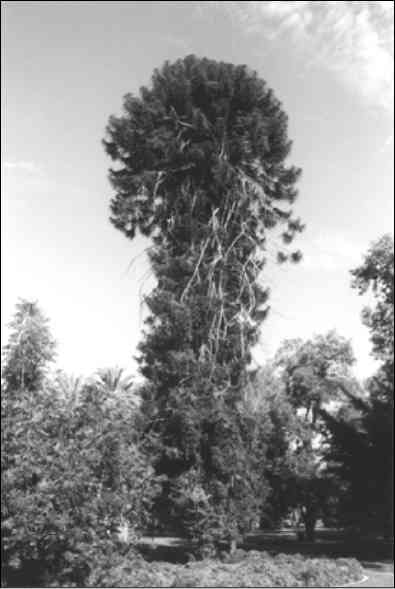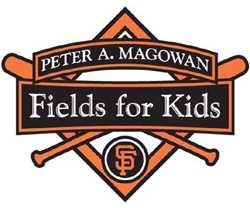Modesto's tallest tree, the Bunya Bunya, located at the corner of Sycamore and Needham. Native to Australia, this tree stands 107 feet tall. It was planted in 1916 to commemorate a gathering of the Native Sons of the Golden West. The planter around the bottom protects visitors from being bombarded with the large 10-20 pound cones that drop from the tree like missiles. | ||
| |||

Graceada Park
Modesto's oldest city park, developed in 1907, Graceada was designed by John McClaren, the designer of Golden Gate Park in San Francisco. It was also one of the first projects of the Women's Improvement Club (WIC), established in 1906 with the intent of developing community parks, planting trees along the streets, paving streets and establishing a library. (WIC was the forerunner of today's Modesto Garden Club.)
The planting of trees was very important to the community since Modesto did not have a natural forest, except along the rivers and streams.
In 1906, the only park in Modesto was at the Courthouse at 11th and I Sts. The park was small and ċalthough it was a community gathering site, it lacked many features that were desired by the citizens of Modesto. "North" Modesto was targeted as the first location for new parks. The northern boundary of Modesto at that time was where Needham Avenue is today. The early streets of Modesto were not laid out in a north/south, east/west direction. They were planned to be parallel and perpendicular to the railroad tracks. The first streets laid out in the more typical manner were those surrounding what would become Graceada Park.
Graceada and Enslen Parks were designed as one park, with Graceada identified in planning stages as the "panhandle" and Enslen the "pan."
The name Graceada comes from the first names of the wives of the families that donated the land for the park - Grace Beard and Ada Wisecarver. Putting the two names together makes Graceada. Enslen Park was named for the Enslen Family, who donated the acreage for the "pan" portion of the park.
McClaren, the designer of the parks, was considered the preeminent landscape architect west of the Mississippi at that time. He traveled to Modesto to design Graceada, Enslen and other early parks. In his design of the parks, McClaren attempted to simulate natural groves of trees. It is easy to pick out the original trees in the park as they are almost all in groupings and are of a large size. About 20% of the original trees can be found in the park today.
The park was developed in 1907. The tennis courts were an original component of the park, as tennis was an up and coming sport at that time. The courts were first laid out in an east-west orientation. Realizing that sun was a problem, the play of the courts was shortly changed to a north-south orientation.The park's amphitheater, Mancini Bowl, was added in the 1940s.
Strolling paths, arbors, and a rose garden were early park features. Enslen Park was built around a baseball playing field, the first large field in the area. When the field needed renovations in 2013, because of Junior Giants involvement, it underwent a complete transformation and was named after former San Francisco Giants Relief Pitcher Jeremy Affeldt (see sidebar with video link below).
Tinkham's observations about Graceada Park, written in 1921, have been fulfilled, although there are problems with park usage resulting in more policing than originally necessary:
"One of the recent benefits to the city of Modesto and one that will be better appreciated as time rolls on, is the beautiful Graceada Park. It was so named in honor of the wives of Thomas Beard and T.P. Wisecarver, Grace and Ada. Previous to the improvement of this park by the Women's Improvement Club, the only park in the city was a small plot of ground on Front at the corner of I Street, which the citizens planted to shade trees. A correspondent writing of this place January 26, 1886, said, "The square near the depot the railroad company will dedicate to the city if they will convert it into a park. Now it is nothing more than a frog pond. Last evening no less than a thousand of these bullfrogs were croaking. A frog pond on Front Street doesn't sound well for the boasted town of Modesto."
For twenty years, there seems to have been no further effort by the city trustees to purchase land or lay off a park until the organization of the Woman's Club . . .Thomas Beard and T.P. Wisecarver donated the club three blocks of land in the northern part of the city for a park.The Wisecarver tract was the larger donation, it being nearly a quarter mile in length and 280 feet in width."
Next: People/James Algar
Previous: Landmarks/Trees and Parks/City of Trees
The photographs of trees (except the 1913 4th Street Park photo)
on this site are by Garry Browning
.

